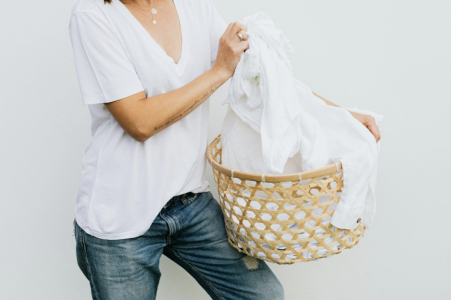The stain removal trick you've always used is a LIE – see what a pro dry cleaner reveals!
- Replies 0
We've been handed down laundry wisdom for generations that seems as timeless as our favourite garments.
The rule that has stood the test of time? The belief is that hot water sets stains, making them a permanent fixture on our favourite clothes. But what if this age-old advice was more myth than matter-of-fact?
Enter Zachary Pozniak, a renowned dry cleaner who decided to put this long-held belief to the test.
Pozniak set out to disprove all our assumptions about stain removal with the help of his Social Media following, who were hungry for laundry legend.
He details his systematic approach in a video that has since captured the attention of viewers worldwide.
Source: Social Media/jeeves_ny
He began by staining four cotton swatches with substances notorious for their stubbornness: pig's blood, grass, olive oil with turmeric, and tomato sauce. After letting the stains set overnight, he subjected each swatch to a different cleaning regimen.
One swatch was washed and rinsed in cold water, another in hot water, a third was pre-treated to tackle the stains head-on, and the final swatch was placed in a tumble dryer for 20 minutes before being washed in warm water.
The results? They were as surprising as they were enlightening.
Ponziak's swatch tests proved that fabric stains were mostly eliminated when cleaned with hot water, debunking the belief that hot water sets stains.
It is worth noting that the pre-treated swatch had the most stains eliminated, but the cold water swatch still had noticeable splotchy staining. It goes to show how crucial it is to pre-treat stains on clothing and bedding before washing them.
As Pozniak explains, ‘Hot water will always remove more stains than cold as there are more interactions between the water, detergent, and stains, which means better cleaning results. This is even true for protein-based stains like blood and grass.’
So, what does this mean for our laundry habits?
Pozniak suggests that we should shift our focus from the washing temperature to the drying process.
Before tossing clothes into the dryer, it's crucial to ensure that stains have been thoroughly removed. Otherwise, the hot air could seal their fate.
Despite the cold water swatch's less-than-stellar performance, cold water remains recommended for most laundry loads.
It's generally just as effective—especially with pre-treatment—and it's kinder to both the environment and your wallet, saving on electricity and money.
We know now to pre-treat those pesky stains, and always double-check your garments before they meet the dryer’s heat. And remember, when it comes to laundry, it's never too late to switch up for new tricks!

Have you been following the hot water laundry myth all your life? What are your tried-and-true stain removal tips? Join the conversation and let us know in the comments below.
The rule that has stood the test of time? The belief is that hot water sets stains, making them a permanent fixture on our favourite clothes. But what if this age-old advice was more myth than matter-of-fact?
Enter Zachary Pozniak, a renowned dry cleaner who decided to put this long-held belief to the test.
Pozniak set out to disprove all our assumptions about stain removal with the help of his Social Media following, who were hungry for laundry legend.
He details his systematic approach in a video that has since captured the attention of viewers worldwide.
Source: Social Media/jeeves_ny
He began by staining four cotton swatches with substances notorious for their stubbornness: pig's blood, grass, olive oil with turmeric, and tomato sauce. After letting the stains set overnight, he subjected each swatch to a different cleaning regimen.
One swatch was washed and rinsed in cold water, another in hot water, a third was pre-treated to tackle the stains head-on, and the final swatch was placed in a tumble dryer for 20 minutes before being washed in warm water.
The results? They were as surprising as they were enlightening.
Ponziak's swatch tests proved that fabric stains were mostly eliminated when cleaned with hot water, debunking the belief that hot water sets stains.
It is worth noting that the pre-treated swatch had the most stains eliminated, but the cold water swatch still had noticeable splotchy staining. It goes to show how crucial it is to pre-treat stains on clothing and bedding before washing them.
As Pozniak explains, ‘Hot water will always remove more stains than cold as there are more interactions between the water, detergent, and stains, which means better cleaning results. This is even true for protein-based stains like blood and grass.’
So, what does this mean for our laundry habits?
Pozniak suggests that we should shift our focus from the washing temperature to the drying process.
Before tossing clothes into the dryer, it's crucial to ensure that stains have been thoroughly removed. Otherwise, the hot air could seal their fate.
Despite the cold water swatch's less-than-stellar performance, cold water remains recommended for most laundry loads.
It's generally just as effective—especially with pre-treatment—and it's kinder to both the environment and your wallet, saving on electricity and money.
We know now to pre-treat those pesky stains, and always double-check your garments before they meet the dryer’s heat. And remember, when it comes to laundry, it's never too late to switch up for new tricks!
Key Takeaways
- A renowned dry cleaner, Zachary Pozniak, conducted tests to debunk the myth that hot water sets stains.
- His Social Media experiment showed that hot water can remove most types of stains more effectively than cold water, contradicting the common belief.
- The experiment used pig's blood, grass, olive oil with turmeric, and tomato sauce as staining agents on cotton swatches.
- Despite the findings, using cold water is still recommended for most washing, as it is often as effective, especially with pre-treatment, and it saves electricity and money.
Have you been following the hot water laundry myth all your life? What are your tried-and-true stain removal tips? Join the conversation and let us know in the comments below.








